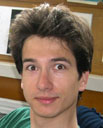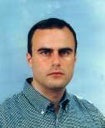Matthew PALMER
Cambridge University
palmer@hep.phy.cam.ac.uk

For my PhD thesis I am working on Beyond the Standard Model physics at the ATLAS detector. My first year involved feasability studies for ATLAS of narrow, well-separated graviton resonances which are possible in Randull-Sundrum models. I analysed the G->WW->lvjj and G->ZZ->lljj decays in a model-independant way. This also involved the use of Grid resources in generating background samples. This year I have been doing studying minature black holes using a full simulation of the ATLAS detector. I am also involved with the Semi-Conductor Tracker for which I have been writing calibration, data acquisition and monitoring software.
Charles PATTISON
Oxford University
charles.pattison@cern.ch

I am working on HARP, a fixed target hadroproduction experiment at CERN designed to measure pion production cross sections for 3-15GeV incident protons on various materials. My involvements include helping in the calibration of the RPCs, a time of flight detector with a precision of 150ps. I am also involved with NA49 to get similar measurements at 160 GeV. These measurements will eventually be input into cosmic shower monte carlos to estimate the atmostpheric neutrino flux.
Roman PEKARIK
Slovak Academy of Sciences, Bratislava
fyzipeka@savba.sk

For my Ph.D. study, I am interested for transition pseudoscalar form factors. I have constructed new model for determination of the neutral pion, eta and eta prime mesons transition form factors in both, space-like and time-like regions simultaneously and my task is to predict various psysical quantities to be measured in HERMES and WASA experiments, where the production of neutral pion and its decay into gamma and electron-positron pair are planned to be performed, respectively.
Ciro PISTILLO
Universita' di Napoli
Ciro.Pistillo@na.infn.it

I am attending the second year of my Ph.D. and my research activity is mainly devoted to the realization and performance tests of a fully automatic microscope of new generation, able to scan large nuclear emulsion areas, with high speed and very good position resolution. The microscope is equipped with fast track recognition processors. This allows the measurement of both track momenta from their multiple scattering and electron and gamma energies from shower development.
This microscope will be used for research activities of the OPERA experiment. OPERA will use the technique of nuclear emulsion to search for the neutrino mu - neutrino tau oscillations in the appearance channel.
I also participate in the test beam activities aimed to understand the performance of the OPERA detector.
Michael
POETTGENS
III. Physikalisches Institut, Aachen
michael.poettgens@cern.ch

I am working on CMS one of the future experiments located at the LHC at CERN. One component of the central tracking system is a silicon strip detector on which I am working. The enormous size of this project requires a thoughtful quality management concerning the production of silicon strip modules which are the basic components of this detector. Thus I develop software for a compact read out system ARC,which was developed at my institute and is spread over the whole collaboration.
Marco POLI LENER
INFN, Frascati
marco.polilener@lnf.infn.it

For my Ph. D. thesis I am working on GEM detectors for LHCb experiment. This detector has been developed in the framework of an R&D activity on detectors for the innemost parts (region 1) of the first muon station (M1) of LHCb experiment. In particular I study and analyze the performance of a triple-GEM detectors with several gas mixtures.

